June 11, 2020 feature
Extremely brilliant giga-electron-volt gamma rays from a two-stage laser-plasma accelerator
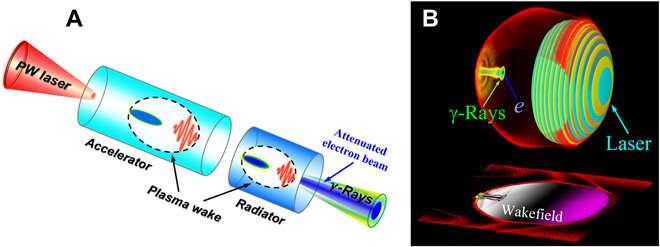
Laser-wakefield accelerators have led to the development of compact, ultrashort X-ray or gamma-ray sources to deliver peak brilliance, similar to conventional synchrotron sources. However, such sources are withheld by low efficiencies and limited to 107-8 photons per shot in the kiloelectron volt (KeV) to megaelectron volt (MeV) range. In a new report now published on Science Advances, Xing-Long Zhu and a research team in physics and astronomy in China and the U.K., presented a new approach to efficiently produce collimated, ultrabright gamma (γ)-ray beams. The resulting photon energies were tunable for up to gigaelectron volts by focussing a multi-petawatt laser pulse into a 2-stage wakefield accelerator. The high-intensity laser allowed them to efficiently generate a multi-gigaelectron volt electron beam with a high density and charge during the first stage of the experiment. The laser and electron beams entered a high-density plasma region in the second stage thereafter. Using numerical simulations, they demonstrated the production of more than 1012 gamma ray photons per shot with energy conversion efficiency above 10 percent for photons above 1 megaelectron volt (MeV) and achieved a peak brilliance above 1026 photons S-1mm-2mrad-2 per 0.1 percent bandwidth at 1 MeV. This research outcome will offer new avenues in both fundamental and applied physics and engineering.
Bright sources of high-energy gamma rays are versatile for broad areas of applications, including fundamental research in astrophysics, particle and nuclear physics, as well as high-resolution imaging. Researchers can improve such applications with compact gamma ray sources with low divergence, short pulse duration, high energy, and high peak brilliance. While widely used synchrotrons and X-ray free electron lasers (XFELS) can deliver X-ray pulses with peak brilliance, they are limited to low photon energies. The size and cost of such research structures can also limit their regular applications. Researchers have therefore rapidly developed compact laser-wakefield accelerators (LWFAs) in the past two decades to offer a radically different approach to drive the acceleration and radiation of high-energy particles on a much smaller scale. Continuous advancements in the field of ultrahigh-power laser technology will enable brilliant high-energy gamma sources. Although scientists have made considerable efforts to develop advanced photon-sources, an alternative method does not currently exist to achieve the peak brilliance of gamma-ray sources compared to the level of XFEL.
Physical Scheme
In this work, Zhu et al. introduced an efficient strategy to produce extremely high brilliance gamma-rays with photon energies up to GeV. They developed the setup on a two-stage LWFA (laser wakefield accelerator), driven by a single multi-PW laser pulse. During the first stage, they used a moderately low-density plasma to produce a multi-GeV electron beam with a high-energy efficiency approximating 40 percent. During the second stage, they used a relatively high density plasma to produce gamma-ray radiation in the MeV to GeV range with an efficiency of more than 10 percent. The resulting photon number, energy efficiency, peak brilliance and power were several orders of magnitude greater than any existing LWFA-based sources, paving the way to facilitate high-brilliance gamma rays across diverse fields of science and technology with photon energy in the range of MeV to GeV.
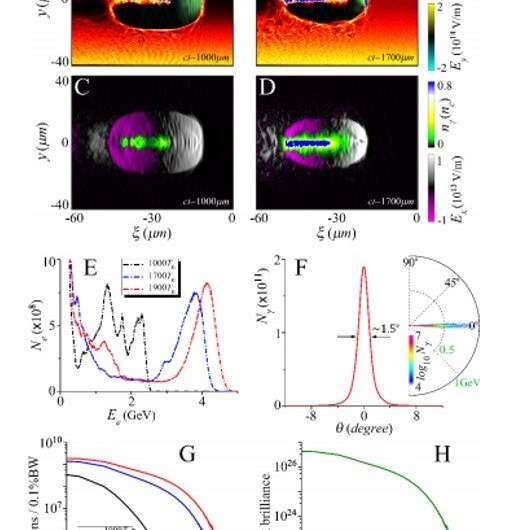
In order to overcome the existing limits, Zhu et al. proposed a two-stage scheme that combined the advantages of efficient electron acceleration in a low-density LWFA and efficient photon emission from energetic electrons in a relatively high-density LWFA. The scientists used a plasma channel to guide the high-power laser. During the first-stage, Zhu et al. self-injected the plasma electrons, which accelerated in the plasma bubble, excited by the multi-PW laser pulse that propagated in an underdense plasma. The resulting low divergence and multi-GeV electron beam achieved a high beam density close to the critical plasma density (1021 cm-3) and a laser-to-electron energy conversion efficiency of up to 40 percent. During the second state, the laser pulse propagated into the relatively high-density plasma and resulted in a shrunken plasma bubble as the density increased. The resulting, large quasi-static electromagnetic fields around the electron beam emitted a collimated beam of gamma-rays with photon-energies at the GeV level.
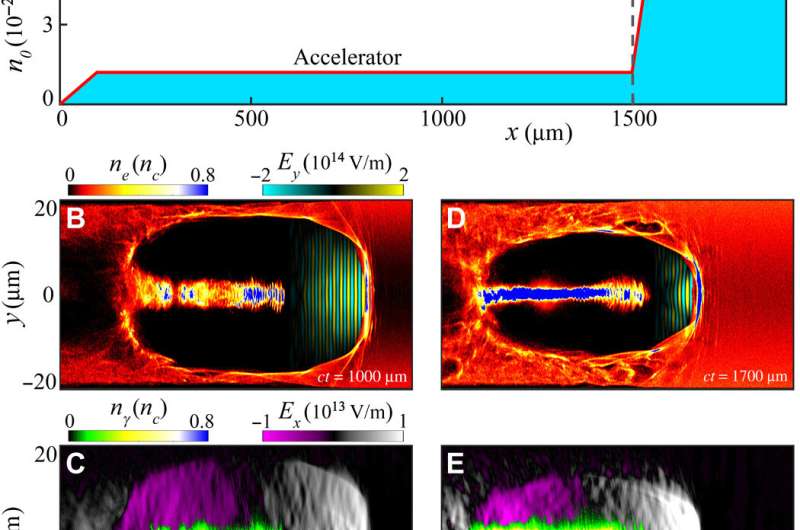
Emission of extremely bright gamma-rays
Since the quasi-static electromagnetic fields were high enough, both radiation reaction and quantum effects in the system played an important role during photon emission. The results indicated an unprecedented radiation efficiency for gamma-rays with photon efficiency above 1 MeV. The photon number, efficiency, peak brilliance and power of the gamma-rays emitted were several orders of magnitudes higher than the existing LWFA betatron radiation and Compton backscattering (i.e. scattering of a photon by an electron) sources. To obtain collimated high-energy gamma-ray pulses, the charge and energy of the accelerated electron beam and quasi-static electromagnetic fields had to be high enough. Zhu et al. tailored the plasma density with moderately low density for efficient acceleration and with relatively high density for efficient radiation to form a high density, high charge, and multi-GeV electron beam.
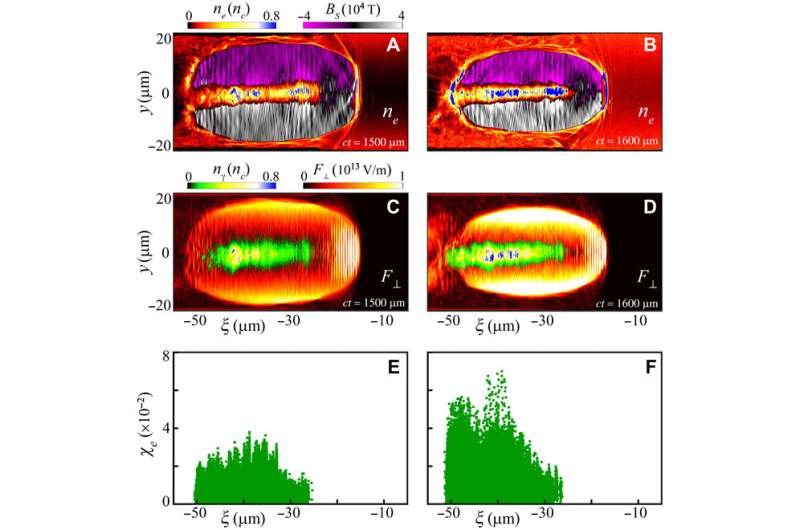
The maximum peak brilliance of gamma-rays reached the XFEL (X-ray free electron lasers) level to make them a promising, high-brilliance and high-energy radiation source for fundamental research and practical applications. The scientists tuned the plasma parameters to change the maximum energy, peak brilliance, and radiation power of the emitted gamma-ray to illustrate the effect of plasma density on gamma-ray emission. The team showed significantly enhanced plasma gamma-ray emission with increased plasma density to facilitate a substantial amount of electron energy transfer to high energy photons. Zhu et al. further optimized the experimental system to prevent the saturation of radiation power and photon energy.
The scientists then demonstrated the robustness of the experimental gamma-ray radiation scheme with a series of simulations for varied laser intensities. The results showed the gamma-ray emissions to become more efficient, with increasing laser intensity. When they reduced the laser intensity, the bright gamma-radiation was still relatively efficient. The scheme can be widely used in laboratories in the near-future to pave way for a new generation of high-efficiency, ultra-bright GeV gamma-ray sources.
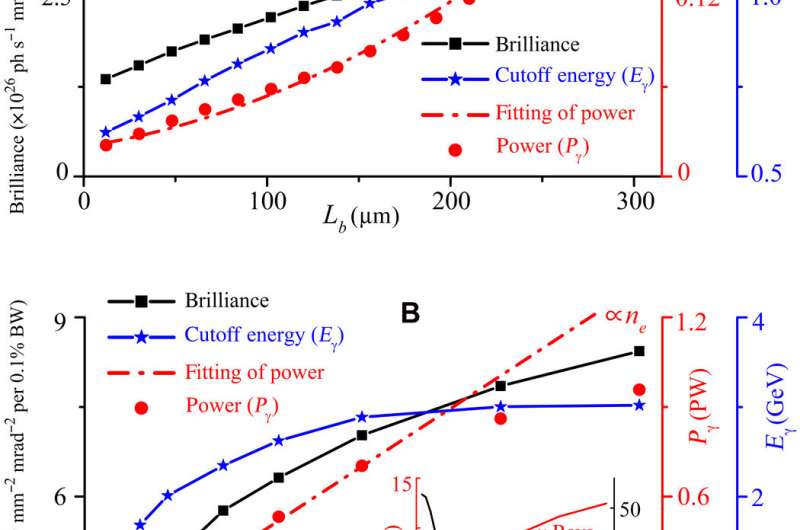
In this way, Xing-Long Zhu and colleagues addressed the existing limits of X-ray and gamma-ray radiation sources and proposed a new and robust scheme. The new method achieved several orders of magnitude increase in the photon number, radiation efficiency, brilliance and power of the emitted gamma-rays. To accomplish this, they used all-optical two-stage LWFA (laser-wakefield accelerators) driven by multi-PW pulses. The work facilitated compact, ultra-short gamma ray sources with unprecedently high brilliance in the GeV regime. The work will offer unique capabilities for a variety of new applications in photonuclear reactions, light-matter interactions, and as gamma-ray colliders.
More information: Xing-Long Zhu et al. Extremely brilliant GeV γ-rays from a two-stage laser-plasma accelerator, Science Advances (2020). DOI: 10.1126/sciadv.aaz7240
undefined undefined. Evidence for light-by-light scattering in heavy-ion collisions with the ATLAS detector at the LHC, Nature Physics (2017). DOI: 10.1038/nphys4208
Anne Sakdinawat et al. Nanoscale X-ray imaging, Nature Photonics (2010). DOI: 10.1038/nphoton.2010.267
Journal information: Science Advances , Nature Physics , Nature Photonics
© 2020 Science X Network




















